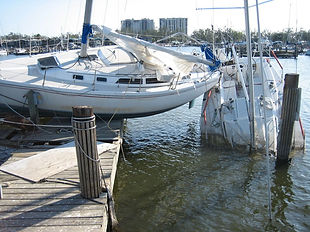Creating A Strong Hurricane Plan To Lower Your Premium
Email or Call 843-410-2990 us if you have any questions, or would like a quote, or you can complete our QUICK QUOTE
Create A Strong Hurricane Plan To Lower Your Premium

All carriers have different hurricane plan guidelines, but below is a good starting point with things to consider, that if presented correctly to underwriters may have an effect on your premium. The factor that has the highest influence on premium is exposure to potential hurricanes, or as the insurance industry calls it "Catastrophe Exposure".
The industry estimation is that as many as 50% of the boats damaged at fixed docks during hurricanes could have been saved by using better dock lines: lines that were longer, larger, arranged better, and/or protected against chafing. Independent studies have shown that boats stored ashore were far less likely to sustain damage than those kept in the water.
Things To Consider:
In Water Hurricane Plan:
-
Be sure that in the event of a Hurricane that you will realistically be able to get to the location listed on your Hurricane Plan
-
Create spider web formations from the vessel to the dock/shore and be sure to not only attach to cleats, but to winches as well. Cleats may rip out under severe pressure
-
Strip all loose gear from deck; bimini tops, exterior cushions, glass, outriggers, main sails and headsails, and canvas covers.
-
The more lines and anchors used, the better
-
Tape the seals on all opening windows and deck hatches to prevent leakage from wind driven rain and salt spray.
-
If you have neighboring vessel that seems unattended, get in touch with the owner.
-
After preparations are complete take a video of your vessel as well as your neighboring vessel.
Hurricane Plan Ashore
-
Be sure that the vessel is stored well above anticipated storm surge
-
Strip all loose gear from deck; bimini tops, exterior cushions, glass, outriggers, main sails and headsails, and canvas covers.
-
Tape the seals on all opening windows and deck hatches to prevent leakage from wind driven rain and salts pray.
-
Using jackstands alone is not enough as over time, the hull can be easily worked out of position by wind gusts and rising water is of course also a concern.
-
Jackstands should be anti-slip and be chained together to prevent movement. If the ground beneath the jackstands is any other than concrete, a minimum of 3/4” plywood should be placed under each stand.
-
Using a minimum of 2 straps and/or 4 mooring lines positioned evenly ensure that your boat is secured to some form of anchor point such as eyes set in concrete or helical anchors drilled into the ground. Use straps with little or no stretch to them.
-
According to industry experts, over the past few hurricanes, this technique of anchoring and strapping down boats ashore has proved to be extremely effective in minimizing the amount of damage seen. Straps placed amidships is much more effective in preventing the vessel from overturning.
-
Other considerations:
If you are unable to be at the vessel to secure it, who will be able to do this?
If the marina decides to evacuate you, do you have a contingency plan?
Most damage to vessels during a Hurricane is from debris, pilings and other unsecured boats, so be aware of your surroundings.
- If you have any questions at all, please dont hesitate to call +1 843 410 2990, or email me hugo@hanhaminsurance.com.
I am ALWAYS happy to help.
- Thanks, Hugo
